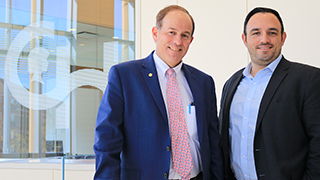HOW CAN WE HELP YOU? Call 1-800-TRY-CHOP
In This Section
New Bioengineering Lab Paves Way for Pediatric Airway Discoveries
 Our basic function as human beings is our ability to communicate, yet we often take for granted how a baby babbles, a child chatters, or a teen raps. A fragile interplay along the vocal tract — from lungs, through the larynx and the vocal cords, to the lips — allows us to speak, swallow, and breathe. When an airway insult or injury interferes with these passages and processes, experts at the Center for Pediatric Airway Disorders combine extraordinary clinical care and innovative translational research to give children the best possible outcomes.
Our basic function as human beings is our ability to communicate, yet we often take for granted how a baby babbles, a child chatters, or a teen raps. A fragile interplay along the vocal tract — from lungs, through the larynx and the vocal cords, to the lips — allows us to speak, swallow, and breathe. When an airway insult or injury interferes with these passages and processes, experts at the Center for Pediatric Airway Disorders combine extraordinary clinical care and innovative translational research to give children the best possible outcomes.
As a Frontier program designated by Children’s Hospital of Philadelphia, the Center is one of the few in the country specializing in tracheal reconstruction, recurrent laryngeal nerve reinnervation, and a variety of other specialized airway procedures. The multidisciplinary team plans to innovate new techniques and devices to advance these complex procedures and develop novel treatment strategies. One arm of this translational research effort involves the launch of a first-of-its kind bioengineering and biomaterials laboratory dedicated to pediatric laryngology.
Research scientist Riccardo Gottardi, PhD, will join CHOP in January as the lab’s principal investigator, and he is eager to get started with the guidance of Ian Jacobs, MD, medical director of the Center for Pediatric Airway Disorders, and the support of the Division of Otolaryngology. The lab’s team will include talented fellows, postdoctoral scientists, graduate students, and others from several fields of science — materials science, bioengineering, microbiology, genomics, and laryngology.
“I’m excited to be part of CHOP’s mission and move bioengineering research forward for pediatric laryngology so that discoveries in the lab reach patients and make a difference in children’s lives,” Dr. Gottardi said.
The lab will take a multiscale, multipronged approach to find optimal ways to regenerate organs, repair tissue, and prevent disease. Leaving “no stone unturned,” they will study from bench to bedside every aspect of common and complex pediatric disorders, and create new devices and biomaterials that are safe and effective throughout the lifespan.
Basic science researchers will work to better understand the biological mechanisms behind how the disease process works. For example, they want to identify which cytokines’ signals may shift the balance from a tissue becoming fibrotic, in order to prevent or lessen injury or damage to the vocal cords.
Through genomic sequencing techniques, the study team aims to determine the genes that may influence why certain patients are prone to develop more scarring than others. Currently, this remains a mystery.
The scientific team also is looking at new ways to model the vocal cords of infants and children. Using microbioreactors and organ-on-chip devices they can recreate organs and tissues in miniaturized in vitro conditions to study how diseases develop and to screen for potential interventions, including controlled drug delivery.
“We want to understand the mechanisms and the signals that are connected to fibrosis, which involves extensive structural airway changes, and the microbiology involved,” Dr. Gottardi said. “Those are areas we’re exploring where very little information is out there. We are among the few labs pioneering this effort in pediatric laryngology.”
The knowledge scientists gain at the cellular level will refine the lab’s approaches to regenerative medicine. Creating new or replacement parts for the body through tissue engineering techniques is especially challenging in pediatrics because scientists must develop tissue that can be integrated by the body as a substitute for the damaged tissue, and then function reliably over many years of child growth and development.
“When damage is already done to a child’s airways, we’re looking at ways to support surgical approaches with better biomaterials and tissue engineered parts, which range from small grafts to replacement of an entire organ like the larynx,” Dr. Jacobs said.
Airway Outreach Nurse Practitioner Kate Hanlon-Ng, who works in the Center for Pediatric Airway Disorders, often interacts with families of babies who are born extremely premature and require technological support for months and sometimes years. She helps them deal with airway injuries resulting from long-term tracheostomy placement that affect their children’s ability to communicate, breathe, swallow effectively, and eat. Being part of one of the first laboratories to apply bioengineering principles to help prevent and treat these types of complications in pediatric airway disorders is “mind-blowing,” she said.
“I see what families go through, and the kids are so resilient and amazing,” Hanlon-Ng said. “Having this opportunity to explore if there are things we can do noninvasively that would improve entire families’ lives is incredible. It’s exciting to truly be at the forefront of this research.”
With a highly committed team carrying out CHOP’s strong mission toward outstanding patient care, a wide patient base from all over the world, a solid infrastructure for research productivity, a collaborative academic ecosystem with the University of Pennsylvania, and internal support as a Frontier Program, the Center for Pediatric Airway Disorders is in a unique position to propel this research forward.
“I’m grateful for the remarkable opportunity to embark on a scientific effort that involves disruptive innovation with a gifted scientist who can rely on the tremendous resources available at CHOP and Penn to build this laboratory to create novel discoveries that are going to directly impact children’s lives,” Dr. Jacobs said.